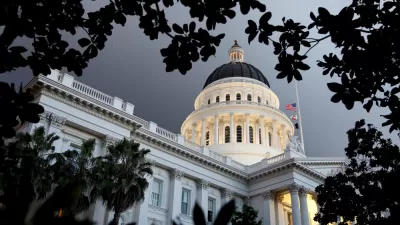Caling the upcoming vote on AB 398, which has created strange political bedfellows, "the most important vote of your life," Gov. Jerry Brown cast the decision as choosing between "massive new regulations" and market-based mechanisms.
At stake is the ability to continue the state's most important mechanism to reduce emissions and fund mitigation. While cap-and-trade withstood a final court challenge last month when the state Supreme Court rejected an appeal by business groups, it's ability to continue operation after 2020 is questionable as the bill that authorized it, AB 32, called for reductions to the year 2020. To ensure the successor program is not challenged as an illegal tax, Gov. Brown wants the bill to pass by a two-thirds supermajority vote.
The legislative package pushed by Gov. Brown, Senate President pro Tempore Kevin de León (D-Los Angeles) and Assembly Speaker Anthony Rendon (D-Paramount) includes AB 617 (Toxic Air Pollution Standards: to increase monitoring and impose stricter penalties on polluters), by Assemblymembers Cristina Garcia (D-Bell Gardens), Eduardo Garcia (D-Coachella), and Miguel Santiago (D-Los Angeles), and AB 398 (California Global Warming Solutions Act of 2006: market-based compliance mechanisms), by Assemblymember Eduardo Garcia (D-Coachella), to continue the current cap-and-trade program beyond 2020.
Planetizen's last post on the continuation of this vital program indicated that the bill backed by leadership was SB 775, initially posted here, that returned much of the revenue raised by cap-and-trade to residents in the form of 'climate dividends.'
"[AB 398] faces opposition from both the right and left, with Republicans questioning its economic impact while environmental justice advocates call it too kind to the oil industry," reports David Baker for the San Francisco Chronicle. However, the politics has created strange bedfellows.
Supporters include such environmental groups as the Natural Resources Defense Council and the Environmental Defense Fund, as well as the California Chamber of Commerce — the organization that sued to upend cap and trade.
Opponents, meanwhile, include the Sierra Club [California] — which believes the bill is too generous to oil companies — and, so far, the Senate Republican caucus.
"The oil lobby has had way too much influence on this legislation," Bill Magavern, policy director of the Coalition for Clean Air, said outside the Capitol on July 10, reports Associated Press writer Kathleen Ronayne.
Market-based mechanism vs. 'command and control'
Cap and trade works by setting an annual limit on the state’s greenhouse gas emissions and forcing companies to buy a permit, called an allowance, for every metric ton of heat-trapping gases they emit. The number of allowances available each year equals the cap, and both decrease over time, reducing emissions.
If companies have a hard time quickly cutting emissions, they can buy allowances from the state, or from each other
Brown warns that without cap-and-trade "the state would switch to using direct 'command and control' regulations—an approach that could mean ordering specific cuts from specific industries on a set timetable," writes Baker. "Cap and trade, by contrast, gives businesses flexibility in how and when they cut emissions and is generally considered to cost less."
If Brown is unable to continue the cap-and-trade program, it may make it more difficult to promote his climate change efforts that he and several other governors initiated in the aftermath of President Trump's June 1 announcement to withdraw from the Paris climate agreement.
FULL STORY: Brown threatens ‘intrusive’ climate rules if cap and trade fails

Alabama: Trump Terminates Settlements for Black Communities Harmed By Raw Sewage
Trump deemed the landmark civil rights agreement “illegal DEI and environmental justice policy.”

Study: Maui’s Plan to Convert Vacation Rentals to Long-Term Housing Could Cause Nearly $1 Billion Economic Loss
The plan would reduce visitor accommodation by 25% resulting in 1,900 jobs lost.

Why Should We Subsidize Public Transportation?
Many public transit agencies face financial stress due to rising costs, declining fare revenue, and declining subsidies. Transit advocates must provide a strong business case for increasing public transit funding.

Paris Bike Boom Leads to Steep Drop in Air Pollution
The French city’s air quality has improved dramatically in the past 20 years, coinciding with a growth in cycling.

Why Housing Costs More to Build in California Than in Texas
Hard costs like labor and materials combined with ‘soft’ costs such as permitting make building in the San Francisco Bay Area almost three times as costly as in Texas cities.

San Diego County Sees a Rise in Urban Coyotes
San Diego County experiences a rise in urban coyotes, as sightings become prevalent throughout its urban neighbourhoods and surrounding areas.
Urban Design for Planners 1: Software Tools
This six-course series explores essential urban design concepts using open source software and equips planners with the tools they need to participate fully in the urban design process.
Planning for Universal Design
Learn the tools for implementing Universal Design in planning regulations.
Smith Gee Studio
Alamo Area Metropolitan Planning Organization
City of Santa Clarita
Institute for Housing and Urban Development Studies (IHS)
City of Grandview
Harvard GSD Executive Education
Toledo-Lucas County Plan Commissions
Salt Lake City
NYU Wagner Graduate School of Public Service



























